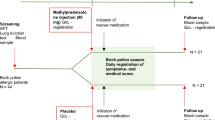Abstract
In Japan, information on daily Japanese cedar pollen counts is made public during pollen season. If symptom severity and treatment outcome are predictable according to these pollen counts, management of seasonal allergic rhinitis may become more precise. The aims of the study were to evaluate the relationship between airborne pollen counts, symptom severity and treatment outcome in Japanese cedar pollinosis patients. In the randomized study, patients with moderate to most severe Japanese pollinosis were treated with fexofenadine (60 mg BD) or fexofenadine and nasal corticosteroids for 2 weeks. During the same period daily airborne pollen counts were measured. A total of 105 adult patients were enrolled. No difference of treatment efficacy was seen among groups. Detailed results of efficacy and safety were previously described elsewhere. In univariate analysis, the mean cumulative amount of airborne pollen exposure for 4 days prior to the study tended to affect symptom severity (P = 0.053) and the mean cumulative amount of airborne pollen during the treatment period tended to show difference among five treatment outcome categories (P = 0.066). In multivariate analysis, the mean cumulative amount of airborne pollen exposure for 4 days prior to the study was identified as the only significant factor of symptom severity (P = 0.0327) and cumulative amount of airborne pollen during the treatment period (P = 0.027) and allergic history (P = 0.027) were significant factors of treatment outcomes. No serious adverse effect was reported during the study. The amount of airborne pollen may be predictive of both symptom severity and treatment outcome.




Similar content being viewed by others
References
Okuda M (2003) Epidemiology of Japanese cedar pollinosis throughout Japan. Ann Allergy Asthma Immunol 91:288–296
Baba K (1998) The Hyper responsiveness of the nasal mucosa for allergens. Practica Oto Rhino Laryngologica 91:209–217
Simola M, Malmberg H (2000) Nasal histamine reactivity; relationships to skin-test responses, allergen provocation and symptom severity in patients with long-continuing allergic rhinitis. Acta Otolaryngol 120:67–71
Takasaki K, Enatsu K, Adachi T et al (2007) Efficacy of fexofenadine monotherapy compared to fexofenadine and nasal steroids in patients with cedar pollinosis. Allergol Immunol 14:66–76
Committee of Allergic Rhinitis Practice Guideline. Practical Guideline for the Management of Allergic Rhinitis in Japan—Perennial Rhinitis and Pollinosis, 5th revision (2005). Tokyo, Japan, Life Science 2005
Baba K (2000) Early phase treatment of Japanese Cedar pollinosis. Allergy Pract 20:194–201
White JF, Levin L, Villareal M, Murphy K, Biagini R, Wellinghoff L, St. Clair HG, Bernstein DI (2005) Lack of correlation between regional pollen counts and precutaneous reactivity to tree pollen extracts in patinets with seasonal allergic rhinitis. Ann Allergy Asthma Immunol 94:240–246
Author information
Authors and Affiliations
Corresponding author
Rights and permissions
About this article
Cite this article
Takasaki, K., Enatsu, K., Kumagami, H. et al. Relationship between airborne pollen count and treatment outcome in Japanese cedar pollinosis patients. Eur Arch Otorhinolaryngol 266, 673–676 (2009). https://doi.org/10.1007/s00405-008-0793-7
Received:
Accepted:
Published:
Issue Date:
DOI: https://doi.org/10.1007/s00405-008-0793-7




